#nobel prize of mathematics
Link
Michel Talagrand, a distinguished mathematician, has been awarded the prestigious Abel Prize for his groundbreaking contributions to the study of randomness. This accolade underscores his remarkable achievements and their profound impact on various scientific disciplines.
The Abel Prize, established in 2001 by the Norwegian government, is one of the most esteemed awards in mathematics. Named after the renowned Norwegian mathematician Niels Henrik Abel, it recognizes outstanding contributions to the field and is often referred to as the Nobel Prize of Mathematics.
0 notes
Text


In 1952, these two men, James Watson and Francis Crick, claimed to have discovered the double helical structure of DNA. In 1962, they were awarded the Nobel Prize in Physiology/Medicine.
Unbeknownst to most at the time, they stole their work from female chemist, Rosalind Franklin. These two men are disgusting misogynists. Science teachers of Tumblr, I beg you to stop posting photos of the men who actively suppressed a woman who made one of the greatest scientific discoveries of all time.
#james watson#francis crock#rosalind franklin#nobel prize#dna#science#scienceblr#medicine#chemistry#chem#math#mathematics#1960s
601 notes
·
View notes
Text

Roger Penrose was born on August 8, 1931. A British mathematician, mathematical physicist, philosopher of science and Nobel Laureate in Physics. Penrose has contributed to the mathematical physics of general relativity and cosmology. He has received several prizes and awards, including the 1988 Wolf Prize in Physics, which he shared with Stephen Hawking for the Penrose–Hawking singularity theorems, and one half of the 2020 Nobel Prize in Physics "for the discovery that black hole formation is a robust prediction of the general theory of relativity". He is regarded as one of the greatest living physicists, mathematicians, and scientists, and is particularly noted for the breadth and depth of his work in both natural and formal sciences.
#roger penrose#mathematicians#mathematics#general relativity#cosmology#singularity#nobel prize#nobel prize winners#science#science history#science birthdays#on this day#on this day in science history
18 notes
·
View notes
Text
•Andrea M. Ghez•

#It looks fuzzy but im hoping that’s just the app being silly#steminist#physics#science#stem#mathematics#maths#sub-at-omicsteminist#nobel prize#black holes#astonomy#space#women in stem#women in science#women’s history
23 notes
·
View notes
Text

#him#we#us#them#native terrestrial#physics#biology#chemistry#mathematics#literature#economics#nobel prize#Switzerland
0 notes
Text
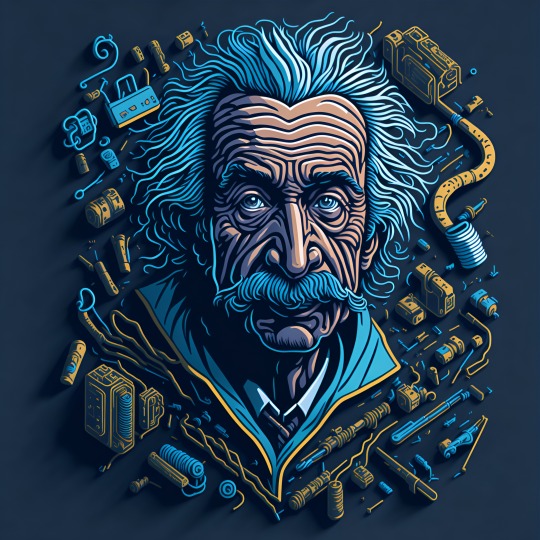
Einstein Unleashed!
#Einstein#sticker#genius#iconic#detailed#inspiration#science#physicist#intellect#imagination#creativity#relativity#theory#E=mc²#academia#mathematics#physics#Nobel Prize#curiosity#revolution#mind-blowing#awe-inspiring#deep thinking#innovation#influential#thought-provoking#wisdom#renowned#legendary#abstract thinking
0 notes
Text



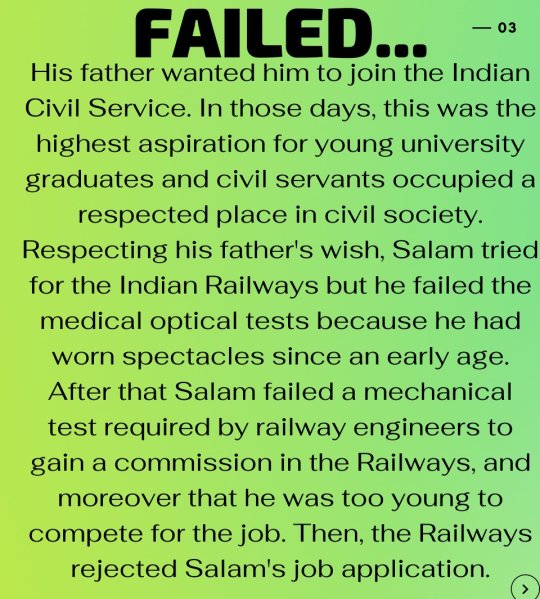


Mohammad Abdus Salam was the first Pakistani and Muslim to receive a Nobel Prize in science and the second from an Islamic country to receive any Nobel Prize.
#mohammad#pakistan#muslim#nobel prize#science#youth#education#university#mathematics#government#college#indian#engineering#job#academy#career#london#physics#field#theory#discover#awards#quantum#filinta
0 notes
Text
What made Einstein a Genius?
Vedic Chart analysis 3
(Birth data source: Astrodatabank)

This man don't need any introduction. World regards him as one of the great scientist ever lived. Here is his chart below:
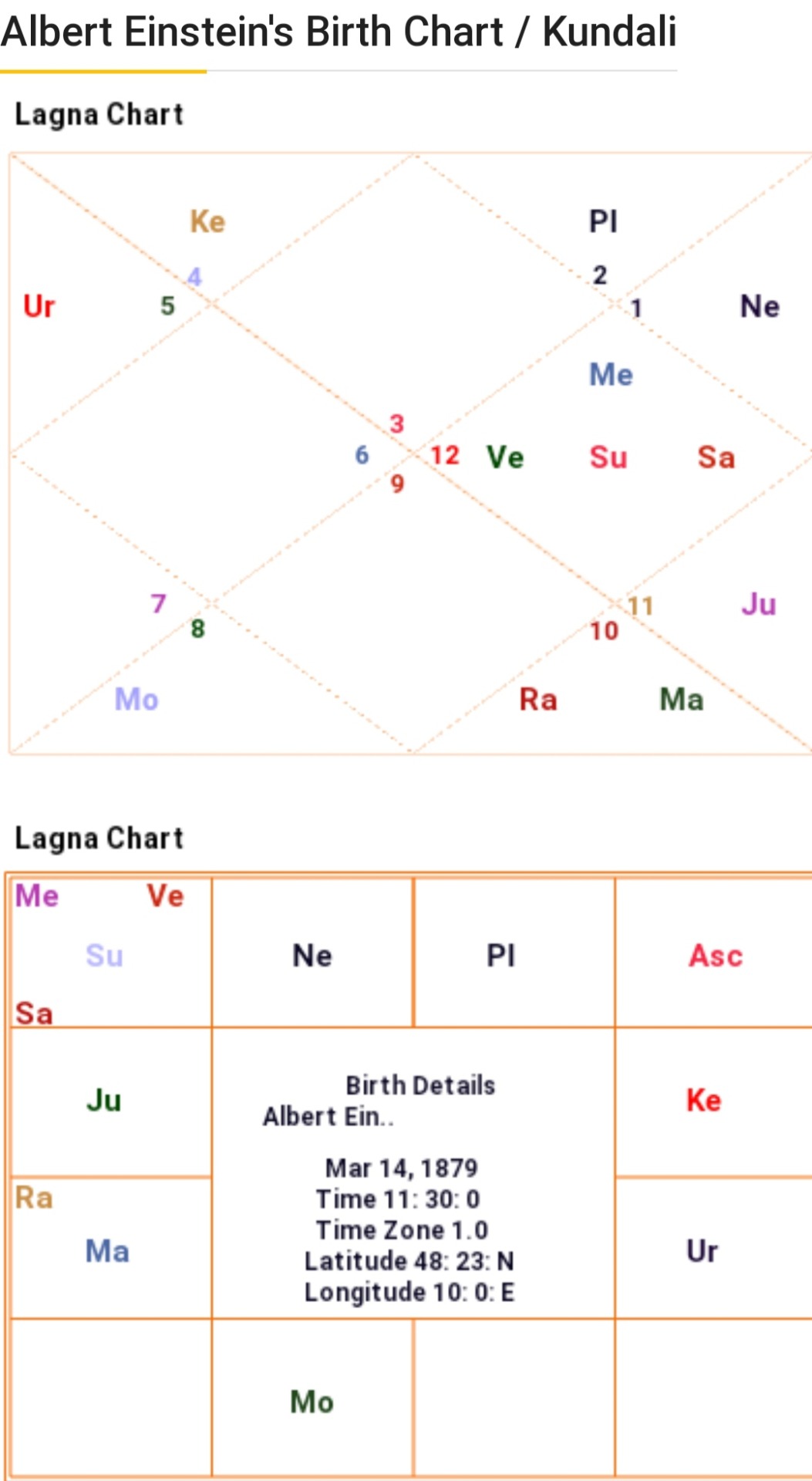

German-Swiss-American scientist, a physicist who developed the theory of relativity in 1905, and the general theory in 1916, laying the groundwork for 20th century physics and providing the essential structure of the cosmos. He was awarded the 1922 Nobel Prize for his contributions to theoretical physics, especially for his discovery of the photo-electric effect law. His name has been synonymous with genius, and the scientific definitions of the modern age--ranging from the Bomb to space travel, electronics and quantum physics - all bear the stamp of his conceptualizations.
His childhood:
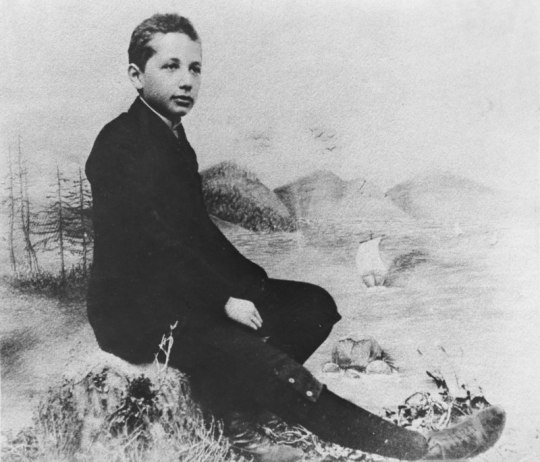
Einstein was born with a misshapen head and abnormally large body to Hermann Einstein and Pauline Koch in Ulm. He learned to talk so late that his parents feared that he was mentally retarded, not until he was three, and was not fluent until he was nine. The reason for his physical disadvantage is obviously the debilitated and afflicted lagna Lord Mercury. Mercury is debilitated in 10th house and afflicted with saturn and sun. The weakness of Mercury affected his speech. Mercury is not in a good shape as it's afflicted in navamsa too with saturn and ketu.
His career:
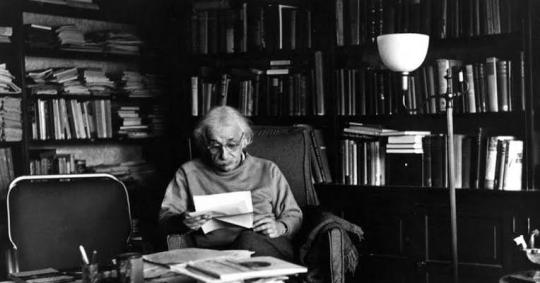
In 1905, he published three seminal papers on theoretical physics. In 1907, he came up with the immortal e=mc2, better known as the Special Theory of Relativity, encapsulating energy and matter as aspects of a single phenomenon. In 1908, while still at the patent office, he began work on his major achievement, the general theory of relativity, which he officially proposed in 1916. The theories were the greatest challenge to Newtonian mechanics that the modern world had ever known. Most of his achievements came to light in the dasha of Venus. Venus is strongly posited in 10th house with exaltation. Venus being the 5th Lord, it provides superior intelligence as it's exalted. Not only that, Venus is placed in Aquarius navamsa. Aquarius is known for scientific innovations. If you look at his birth chart, you could see that he has prominent karmas related to career as his 10th house got stellium (Venus, Mercury, sun and saturn). Mercury , Venus and saturn combination provides a great rajyoga for Gemini rising. It is present in 10th house of career. So he was destined to shine in his work field. Ascendant Lord in 10th house made him occupied in his work. His works were quite imaginary. His famous quote goes like this : "Imagination is important than knowledge. " His quote reflects his piscean quality of unique imagination which gave birth to his scientific discoveries. His Mars is exalted in 8th house with rahu. So it gives a research mindset as 8th house is connected to research. His Rahu and Jupiter subperiods in Venus where he did great work. His Rahu is posited in 8th house of research with exalted Mars. His Jupiter is posited in technical zodiac Aquarius in exchange with saturn in pisces. It's the 9th and 10th Lord exchange which is regarded highly in vedic astrology. It's called parivartan yog which creates dharmakarmadhipati yog. He won Nobel in 1921( Sun period and Venus subperiod). These factors contributed to his great achievements.
His love life:
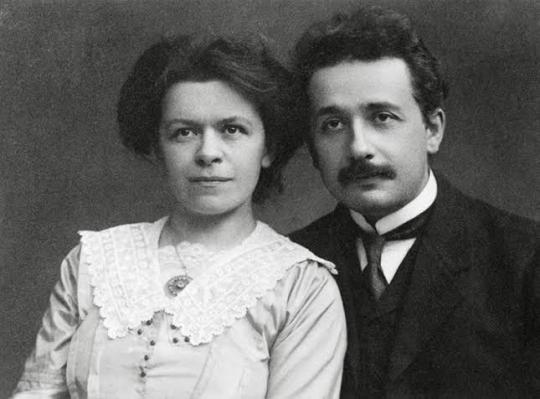
His first wife, Mileva Maric, was a Serbian who dreamed of becoming a physicist. She was 21 when she entered the Swiss Federal Institute of Technology in Zurich. She had met Einstein when she was 17 and they were married in 1903. Mileva Marić and Albert Einstein met in 1896, when both enrolled in the course VIA for intending teachers of mathematics and physics in secondary schools. From the letters they exchanged from late 1897 through 1898 it is evident that they soon developed a close relationship. It is prominent that he had met his girl in Venus period and Venus subperiod. So, a functional benefic and 5th lord of romance Venus sparked love in Einstein's life. His Venus is in Aquarius navamsa which indicates that his wife might be involved in science. But they were seperated later. His affliction to Venus from saturn and sun made his love life very difficult. There is a lot of mystery surrounding his child. The daughter was named Lieserl and soon mysteriously vanished. His 5th Lord Venus is conjunct with mysterious 8th Lord Saturn which reflects his daughter's secret disappearance.
His other aspects of life:

He was not always comfortable with the theories and findings in physics for which he had laid the groundwork. A musician by hobby, he gave up the violin in the last few years of his life, but enjoyed playing Bach and Mozart on his grand piano. His powerful Venus in exaltation provides him interest in music. He was infidel in 1912 due to his Venus in Aquarius navamsa which is known for breaking boundaries. From 1922 until 1932, with the exception of a few months in 1923 and 1924, Einstein was a member of the Geneva-based International Committee on Intellectual Cooperation of the League of Nations, a group set up by the League to encourage scientists, artists, scholars, teachers and other people engaged in the life of the mind to work more closely with their counterparts in other countries. He was going through moon period which made him part of service since moon is present in 6th house of service. In March and April 1925, Einstein and his wife visited South America, where they spent about a week in Brazil, a week in Uruguay and a month in Argentina. It was in Jupiter subperiod. Jupiter in 9th house of exploration made him travel. In 1939, he urged President Roosevelt to move towards construction of a uranium bomb, since there was some evidence other countries were also moving in that direction. He had given up his pacifist ideals in 1939 as his Mars is quite strong in Capricorn. His Mars is conjunct Rahu. Mars Rahu combination is infamous for extreme violence. In his case, this combination is formed in 8th house of secrecy. So it indicates that he had a violent part in him which was quite hidden from public.
Well..I tried to analyse few aspects of a scientist. That's it for now. Hope you enjoyed reading.
30 notes
·
View notes
Text
In 1968, the American scholar Jerome M. Gilison described Soviet elections as a “psychological curiosity”—a ritualized, performative affirmation of the regime rather than a real vote in any sense of the word. These staged elections with their nearly unanimous official results, Gilison wrote, served to isolate non-conformists and weld the people to their regime.
Last Sunday, Russia completed the circle and returned to Soviet practice. State election officials reported that 87 percent of Russians had cast their vote for Vladimir Putin in national elections, giving the Russian president a fifth term in office. Not only were many of the reported election numbers mathematically impossible, but there was also no longer much of a choice: All prominent opposition figures had been either murdered, imprisoned, or exiled. Like in Soviet times, the election also welded Russians to their regime by serving as a referendum on Putin’s war against Ukraine. All in all, last weekend’s Soviet-style election sealed Putin’s transformation of post-Communist Russia into a repressive society with many of the features of Soviet totalitarianism.
Russia’s return to Soviet practice goes far beyond elections. A recent study by exiled Russian journalists from Proekt Media used data to determine that Russia is more politically repressive today than the Soviet Union under all leaders since Joseph Stalin. During the last six years, the study reports, the Putin regime has indicted 5,613 Russians on explicitly political charges—including “discrediting the army,” “disseminating misinformation,” “justification of terrorism,” and other purported crimes, which have been widely used to punish criticism of Russia’s war on Ukraine and justification of Ukraine’s defense of its territory. This number is significantly greater than in any other six-year period of Soviet rule after 1956—all the more glaring given that Russia’s population is only half that of the Soviet Union before its collapse.
In addition to repressive criminal charges and sentences, over the last six years more than 105,000 people have been tried on administrative charges, which carry heavy fines and compulsory labor for up to 30 days without appeal. Many of these individuals were punished for taking part in unsanctioned marches or political activity, including anti-war protests. Others were charged with violations of COVID pandemic regulations. Such administrative punishments are administered and implemented rapidly, without time for an appeal.
On March 4, 2022, a little over a week after the Russian invasion of Ukraine began, Russia’s puppet parliament rapidly adopted amendments to the Russian Criminal Code and Criminal Procedure Code that established criminal and administrative punishments for the vague transgressions of “discrediting” the Russian military or disseminating “false information” about it. This widely expanded the repressive powers of the state to criminally prosecute political beliefs and activity. Prosecutions have surged since the new laws were passed, likely leading to a dramatic increase in the number of political prisoners in the coming years. In particular, punishments for “discrediting the army” or “justification of terrorism”—which includes voicing support for Ukraine’s right to defend itself—have resulted in hundreds of sentences meted out each year since the war began. The most recent such case: On Feb. 27, the 70-year-old co-chairman of the Nobel Peace Prize-winning human rights group Memorial, Oleg Orlov, was sentenced to two and a half years in prison for “discrediting” the Russian military.
As the Proekt report ominously concludes, “[I]n terms of repression, Putin has long ago surpassed almost all Soviet general secretaries, except for one—Joseph Stalin.” While this conclusion is in itself significant, it is only the tip of the iceberg of the totalitarian state Putin has gradually and systematically rebuilt.
As in the Soviet years, there is no independent media in Russia today. The last of these news organizations were banned or fled the country after Putin’s all-out war on Ukraine, including Proekt, Meduza, Ekho Moskvy, Nobel Prize-winning Novaya Gazeta, and TV Dozhd. In their place, strictly regime-aligned newspapers, social media, and television and radio stations emit a steady drumbeat of militaristic propaganda, promote Russian imperialist grandeur, and celebrate Putin as the country’s infallible commander in chief. In another reprise of totalitarian practice, lists of banned books have been dramatically expanded and thousands of titles have been removed from the shelves of Russian libraries and bookstores. Bans have been extended to numerous Wikipedia pages, social media channels, and websites.
Human rights activists and independent civic leaders have been jailed, physically attacked, intimidated into silence, or driven into exile. Civic organizations that show independence from the state are banned as “undesirable” and subjected to fines and prosecution if they continue to operate. The most recent such organizations include the Andrei Sakharov Foundation, Memorial, the legendary Moscow Helsinki Group, and the EU-Russia Civil Society Forum. In their place, the state finances a vast array of pro-regime and pro-war groups, with significant state resources supporting youth groups that promote the cult of Putin and educate children in martial values to prepare them for military service. Then there are the numerous murders of opposition leaders, journalists, and activists at home and abroad. Through these various means, almost all critical Russian voices have been silenced.
Private and family life is also increasingly coming under the scope of government regulation and persecution. The web of repression particularly affects the LGBT community, putting large numbers of Russians in direct peril. A court ruling in 2023 declared the “international LGBT movement” extremist and banned the rainbow flag as a forbidden symbol, which was quickly followed by raids and arrests. Homosexuality has been reclassified as an illness, and Russian gay rights organizations have shut down their operations for fear of prosecution. Legislation aimed at reinforcing “traditional values”—including the right of husbands to discipline their wives—has led to the reduction in sentences and the decriminalization of some forms of domestic violence.
Many of the techniques of totalitarian control now operating throughout Russia were first incubated in territories where the Kremlin spread war and conflict. Chechnya was the first testing ground for widespread repression, including massive numbers of victims subjected to imprisonment, execution, disappearance, torture, and rape. Coupled with the merciless targeting of civilians in Russia’s two wars in Chechnya, these practices normalized wanton criminal behavior within Russian state security structures. Out of this crucible of fear and intimidation, Putin has shaped a culture and means of governing that were further elaborated in other places Russia invaded and eventually came to Russia itself.
In Russian-occupied Crimea and eastern Ukraine since 2014, there has been a widespread campaign of surveillance, summary executions, arrests, torture, and intimidation—all entirely consistent with Soviet practice toward conquered populations. More recently, this includes the old practice of forced political recantations: A Telegram channel ominously called Crimean SMERSH (a portmanteau of the Russian words for “death to spies,” coined by Stalin himself) has posted dozens of videos of frightened Ukrainians recanting their Ukrainian identity or the display of Ukrainian symbols. Made in conjunction with police operations, these videos appear to be coordinated with state security services.
In the parts of Ukraine newly occupied since 2022, human rights groups have widely documented human rights abuses and potential war crimes. These include the abduction of children, imprisonment of Ukrainians in a system of filtration camps that recall the Soviet gulags, and the systematic use of rape and torture to break the will of Ukrainians. Castrations of Ukrainian men have also been employed.
As Russia’s violence in Ukraine has expanded, so, too, has the acceptance of these abominations throughout the state and in much of society. As during the Stalin era, the cult of cruelty and the culture of fear are now the legal and moral standards. The climate of fear initially employed to assert order in occupied regions is now being applied to Russia itself. In this context, the murder of Alexei Navalny ahead of the presidential election was an important message from Putin to the Russian people: There is no longer any alternative to the war and repressive political order he has imposed, of which Navalny’s elimination is a part.
All the techniques and means of repression bespeak a criminal regime that now closely resembles the totalitarian rule of Stalin, whom Putin now fully embraces. After Putin first came to power in 1999, he often praised Stalin as a great war leader while disapproving of his cruelty and brutality. But as Putin pivoted toward war and repression, Russia has systematically promoted a more positive image of Stalin. High school textbooks not only celebrate his legacy but also whitewash his terror regime. There has been a proliferation of new Stalin monuments, with more than 100 throughout the country today. On state-controlled media, Russian propagandists consistently hammer away on the theme of Stalin’s greatness and underscore similarities between his wartime leadership and Putin’s. Discussion of Stalinist terror has disappeared, as has the memorialization of his millions of victims. Whereas only one in five Russians had a positive view of Stalin in the 1990s, polls conducted over the last five years show that number has risen to between 60 percent and 70 percent. In normalizing Stalin, Putin is not glossing over the tyrant’s crimes; rather, he is deliberately normalizing Stalin as a justification for his own war-making and repression.
Putin now resembles Stalin more closely than any other Soviet or Russian leader. Unlike Nikita Khrushchev, Leonid Brezhnev, Konstantin Chernenko, and Yuri Andropov—not to mention Mikhail Gorbachev and Boris Yeltsin—Putin has unquestioned power that is not shared or limited in any way by parliament, courts, or a Politburo. State propaganda has created a Stalin-like personality cult that lionizes Putin’s absolute power, genius as a leader, and role as a brilliant wartime generalissimo. It projects him as the fearsome and all-powerful head of a militarized nation aiming, like Stalin, to defeat a “Nazi” regime in Ukraine and reassert hegemony over Eastern and Central Europe. Just as Stalin made effective use of the Russian Orthodox Church to support Russia’s effort during World War II, Putin has effectively used Russian Orthodox Patriarch Kirill as a critical ally and cheerleader of Russia’s brutal war in Ukraine. And just like Stalin, Putin has made invading neighboring countries and annexing territory a central focus of the Kremlin’s foreign policy.
Putin’s descent into tyranny has been accompanied by his gradual isolation from the rest of society. Like the latter-day Stalin, Putin began living an isolated life as a bachelor even before the COVID-19 pandemic hit. Like the later Stalin, Putin lacks a stable family life and is believed to have replaced it with a string of mistresses, some of whom are reported to have borne him children for whom he remains a remote figure. Like Stalin, he stays up late into the early-morning hours, and like the Soviet dictator, Putin has assembled around him a small coterie of trusted intimates, mostly men in their 60s and 70s, with whom he has maintained friendships for decades, including businessmen Yury Kovalchuk and Igor Sechin, Defense Minister Sergei Shoigu, and security chief Nikolai Patrushev. This coterie resembles Stalin’s small network of cronies: security chief Lavrentiy Beria, military leader Kliment Voroshilov, and Communist Party official Georgy Malenkov. To others in leadership positions, Putin is a distant, absolute leader who openly humiliates seemingly powerful officials, such as spy chief Sergey Naryshkin, when the latter seemed to hesitate in his support during Putin’s declaration of war on Ukraine.
Through near-total control of domestic civic life and media, his widening campaign of repression and terror, relentless state propaganda promoting his personality cult, and his vast geopolitical ambitions, Putin is consciously mimicking the Stalin playbook, especially the parts of that playbook dealing with World War II. Even if Putin has no love for Soviet Communist ideology, he has transformed Russia and its people in ways that are no less fundamental than Stalin’s efforts to shape a new Soviet man.
Putin’s massive victory in a Soviet-style election last weekend represents the ratification by the Russian people of his brutal war, militarization of Russian society, and establishment of a totalitarian dictatorship. It is a good moment to acknowledge that Russia’s descent into tyranny, mobilization of society onto a war footing, spread of hatred for the West, and indoctrination of the population in imperialist tropes represent far more than a threat to Ukraine. Russia’s transformation into a neo-Stalinist, neo-imperialist power represents a rising threat to the United States, its European allies, and other states on Russia’s periphery. By recognizing how deeply Russia has changed and how significantly Putin is borrowing from Stalin’s playbook, we can better understand that meeting the modern-day Russian threat will require as much consistency and as deep a commitment as when the West faced down Stalin’s Soviet Union at the height of the Cold War.
20 notes
·
View notes
Text
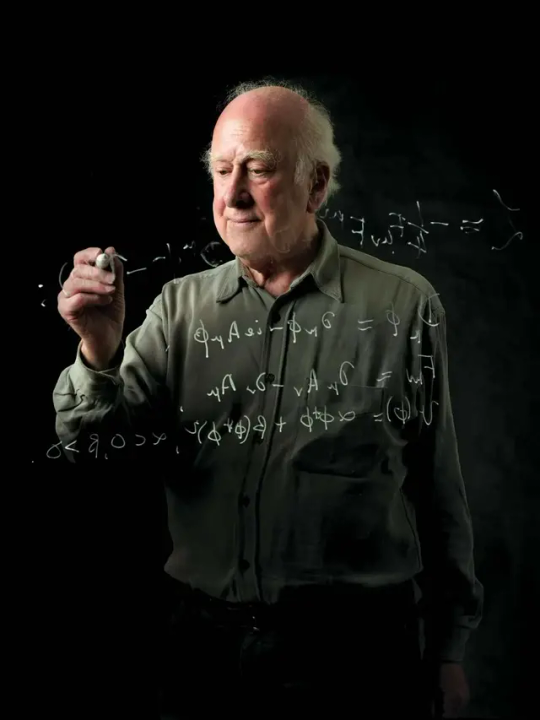
In 1964 the theoretical physicist Peter Higgs, who has died aged 94, suggested that the universe contains an all-pervading essence that can be manifested in the form of particles. This idea inspired governments to spend billions to find what became known as Higgs bosons.
The so-called “Higgs mechanism” controls the rate of thermonuclear fusion that powers the sun, but for which this engine of the solar system would have expired long before evolution had time to work its miracles on earth. The structure of atoms and matter and, arguably, existence itself are all suspected to arise as a result of the mechanism, whose veracity was proved with the experimental discovery of the Higgs boson in 2012.
The Nobel laureate physicist Leon Lederman infamously described the boson as “the God particle”. Higgs, an atheist, found this inappropriate and misleading, but the name stuck and helped bring fame to the idea, and to Higgs. He in turn became a Nobel prizewinner in 2013.
It was at Edinburgh University, as a young lecturer in mathematical physics in the early 1960s, that Higgs became interested in the profound and tantalising ways in which properties – mathematical symmetries – in the equations describing fundamental laws can be hidden in the structures that arise.
For example, in space, unaffected by the earth’s gravity, a droplet of water looks the same in all directions: it is spherically symmetric, in agreement with the symmetry implied by the underlying mathematical equations describing the behaviour of water molecules. Yet when water freezes, the resulting snowflake takes up a different symmetry – its shape only appearing the same when rotated through multiples of 60 degrees – even though the underlying equations remain the same.
The Japanese-American physicist Yoichiro Nambu first inspired interest in this phenomenon, known as spontaneous symmetry breaking, in 1960.
Inspired by Nambu’s work, in 1964 Higgs’s own theory emerged with its explanation of how equations that call for massless particles (such as the quantum theory of the electromagnetic field, which leads to the massless photon) can, via the so-called Higgs mechanism, give rise to particles with a mass.
This idea would later be at the root of Gerardus ’t Hooft’s proof in 1971 that unification of the electromagnetic force and the weak force, responsible for radioactivity, where a massive “W” particle plays the analogous role to the massless photon, is viable. The subsequent discovery of the W in 1983 gained Nobel prizes, both for the experiment and for theorists who had foreseen this. Underlying this success was the so-called Higgs mechanism, which controlled the mathematics in this explanation of the weak force.
When Nambu won the Nobel prize in 2008, it began to seem likely that the way was being prepared for Higgs’s eventual recognition.
A problem though, as Higgs was always the first to stress, was that he had not been alone in discovering the possibility of mass “spontaneously” appearing. Similar ideas had already been articulated: by the condensed matter physicist Philip Anderson, though in a more restricted way, and by Robert Brout and François Englert in Belgium, who beat Higgs into print by a few weeks. A former colleague of Higgs at Imperial College, Tom Kibble, and two colleagues were to write a paper along similar lines weeks later.
Where Higgs had justifiable claims to uniqueness was in the boson. He drew attention to the fact that in certain circumstances spontaneously broken symmetry implied that a massive particle should appear, whose affinity for interacting with other particles would be in proportion to their masses.
It would be discovery of this particle that could give experimental verification that the theory is indeed a description of nature. Although even this boson was arguably implicit in other work, it was Higgs who articulated most sharply its implications in particle physics.
The eponymous “Higgs boson” became the standard-bearer for the Large Hadron Collider. In the early 1990s the science minister William Waldegrave issued his challenge: explain the Higgs boson on a sheet of paper and help me to convince the government to fund this.
Among the winners, the most famous was the analogy, by David Miller of University College London, of Margaret Thatcher – a massive particle – wandering through a cocktail party at the Tory conference and gathering hangers-on as she moved. Higgs, whose politics were diametrically opposite to hers, expressed himself as being “very comfortable” with the description.
He was always uncomfortable as a celebrity. When Cern – the European Organisation for Nuclear Research – prepared to switch on the Large Hadron Collider (LHC) in 2008, the media promoted it as a quest for the Higgs boson.
Higgs felt that Cern was misguided to talk up “the” boson – he was always the first to stress that others had had much the same idea and that naming it after him was unfair. He once modestly described the detection of the boson as “tying up loose ends” and regarded the main excitement of the LHC as its potential to reveal the secrets of dark matter and other kinds of new physics.
Nonetheless, in July 2012, Cern announced the discovery of a particle “with Higgs-like properties”. Media frenzy grew, and Higgs bravely accepted his fate as a centre of attention.
Although most physicists were sure that the eponymous boson had been discovered, several months’ more study would be needed before complete confirmation could be assured: the Nobel prize for 2012 went elsewhere. By 2013 the evidence was compelling; there was a general expectation that 2013 would be the year.
By this stage, 49 years had elapsed since Higgs had written his first paper on the subject. In a final, nailbiting twist, the announcement of his long-awaited success was delayed by an hour as the Nobel committee struggled to reach the famously reclusive scientist. Aware of the media attention he was likely to get, Higgs had decided to be “somewhere else” when the announcement was made, and told colleagues that he planned to take a holiday in the north-west highlands of Scotland.
As the date approached, however, he realised that this was not a good plan for that time of the year, so he decided to stay at home and be somewhere else at the right time. At around 11am on 8 October, he left home and by noon, when the announcement should have been made, he was in Leith, by the shore, in a bar called the Vintage, which Higgs famously attested sold both food and “rather good beers”.
Thus with Higgs incommunicado (he largely avoided using mobile phones or the internet), after more than an hour of unsuccessful attempts to reach him, the Swedish Academy decided to make the public announcement anyway. The ironic result was that by 2pm, the news that Peter Higgs and Englert, of the Université Libre de Bruxelles, were the winners of the Nobel prize for physics was known to the world, but not to Higgs himself. (Englert’s colleague Brout had died in 2011, and was unable to be included as Nobel prizes are not awarded posthumously.)
Higgs later recalled how, “after a suitable interval”, but still ignorant of the news, he had made his way home from lunch. However, he delayed further by visiting an art exhibition, as “it seemed too early to get home, where reporters would probably be gathered”.
At about three o’clock he was walking along Heriot Row, heading for his flat in the next street, when a car pulled up near Queen Street Gardens. A lady got out “in a very excited state” and told Higgs: “My daughter’s just phoned from London and told me about the award.” To which Higgs replied: “What award?” As he explained, he was joking, but that is when his expectations were confirmed.
His plan had been a success, as, “I managed to get in my front door with no more damage than one photographer lying in wait.” A little more than a decade later, the main focus of the LHC has been to produce large numbers of Higgs bosons in order to understand the nature of the omnipresent essence that they form.
During the coronavirus lockdown I talked with him for hours on the phone at weekends in the course of researching the biography Elusive: How Peter Higgs Solved the Mystery of Mass (2022). When asked to summarise his perspective on public reaction to the boson he said: “It ruined my life.” To know nature through mathematics, to see your theory confirmed, to win the plaudits of peers and win a Nobel prize, how could this equate with ruin? He explained: “My relatively peaceful existence was ending. I dont enjoy this sort of publicity. My style is to work in isolation, and occasionally have a bright idea.”
Higgs spent more than half a century as a theoretical physicist at Edinburgh University. Perhaps because of this, he was described in many media reports as a “Scottish physicist”, whereas in fact he was born in Newcastle, of English parents, Thomas Ware Higgs and Gertrude Maud (nee Coghill).
His father was a sound engineer with the BBC, and the family moved almost immediately to Birmingham, where Peter spent his first 11 years. In 1941, with the second world war intensifying, the BBC decided that Birmingham was too dangerous, and its operations were transferred to Bristol. The Higgs family duly moved there, with the intention of avoiding aerial bombardment, but the following weekend the centre of Bristol was heavily bombed.
In Bristol, Higgs attended Cotham grammar school, where a famous former pupil had been the Nobel physicist Paul Dirac. Dirac’s name was prominent on the honours board. Higgs followed him, but initially in mathematics rather than physics. Higgs’s father had a collection of maths books, which inspired Peter and enabled him to be become far ahead of the class. His interest in physics was sparked in 1946, upon hearing the Bristol physicists, later Nobel laureates, Cecil Powell and Nevill Mott describing the background to the atomic bomb programme. Although this helped determine his career, Higgs himself later became a member of CND.
At King’s College London he studied theoretical physics, going on to gain his PhD in 1954. He was working on molecular physics, applying ideas of symmetry to molecular structure. His interests moved towards particle physics, although his office was on the same corridor as those of Rosalind Franklin and Maurice Wilkins, two of the co-discoverers of the structure of DNA, though his own work had no immediate link to their programme.
He won research fellowships, first at the University of Edinburgh (1954-56), then in London at University College (1956–57), and at Imperial College(1957–58). He was appointed lecturer in mathematics at University College London in 1958, and then moved to the University of Edinburgh in 1960, where he spent the rest of his research career. Initially lecturer in mathematical physics, in 1970 he was appointed reader and, in 1980, professor of theoretical physics. He was elected Fellow of the Royal Society of Edinburgh in 1974, and FRS in 1983.
He met his future wife, the linguist Jody Williamson, at a CND meeting in 1960. They married in 1963, and had two sons, Christopher and Jonathan. Although they separated, they remained friends until her death in 2008.
Higgs won several awards in addition to the 2013 Nobel prize. In addition to numerous honorary degrees, these included the 1997 Dirac medal and prize from the Institute of Physics, the 2004 Wolf prize in physics, the Sakurai prize of the American Physical Society in 2010, and the Edinburgh medal in 2013. That year he was also appointed Companion of Honour, and two years later he won the Copley medal of the Royal Society, the world’s oldest scientific prize.
His sons survive him.
🔔 Peter Ware Higgs, theoretical physicist, born 29 May 1929; died 8 April 2024
Daily inspiration. Discover more photos at Just for Books…?
16 notes
·
View notes
Text

Best Greetings
Planet Diameter Is Created As A Function In The Rotation Period
PLANET DIAMETER EQUATION
First/ The Equation Definition
The equation proves planet diameter is created by a mathematical equation-
Planet diameter is NOT created by random process, BUT By A Geometrical Rule-
Means–Planet creation data is defined based on geometrical rules and NOT randomly
The airplane industry helps to understand, the manufacturer needs exact equations to define the airplane length, width, weight and all dimensions - otherwise this airplane can't fly safely- similar to that- the planet creation data (diameter, mass and all data) need to be defined based on exact equations otherwise the planet can't move safely-
Let's see the planet diameter equation in following…
Second / Planet Diameter Equation tells ((v1/v2)=(s/r)=I)
(v= planet velocity, r= planet diameter, I= planet orbital inclination, and s= planet rotation periods number in its orbital period- the factors v2,s,r and I are belonged to one planet and v1 is belonged to another planet)
The equation works from the Earth to Pluto only (the discussion explains the reason)
The planet (v1) is defined by minimum error test-
Earth Equation uses Neptune velocity
Mars Equation uses Pluto velocity
Jupiter Equation uses the Earth moon velocity
Saturn Equation uses Mars velocity
Uranus Equation uses Neptune velocity (As Earth)
Neptune Equation uses Saturn velocity
Pluto Equation uses the Earth moon velocity (As Jupiter)
Example
Neptune Equation (89143 /49528) = 9.7/ 5.4 =1.8
89143 = Neptune rotation periods number in Neptune orbital period
49528 km = Neptune diameter
9.7 km/s = Saturn velocity
5.4 km/s = Neptune velocity
59800 days = Neptune orbital period (and Neptune rotation period =16.1 hours)
1.8 degrees = Neptune Orbital Inclination
The Equation Concept
The equation tells, planet diameter is created as a function in its rotation period and the rotation period is a function in its velocity and the velocity is a function in its orbital distance – but why??
Planet diameter should be a function in its orbital distance for the planet safe motion otherwise this planet can be broken by its motion as a result for the inconsistency between the planet diameter and its orbital distance
BUT- the designer couldn't create Planet diameter and its orbital distance in one function only- Because if the planet changes its orbit its diameter will be broken also- for that- the designer created the planet diameter a function in its rotation period and the rotation is a function in its velocity and the velocity is a function in its orbital distance- and
In case the planet changes its orbit around the sun, its diameter wouldn't be broken but the planet would change its velocity, its rotation period, its orbital period and its orbital inclination but the diameter will be saved.
NOTICE
The equation tells – for example- Uranus diameter is created 51118 km and never changes since its creation during the history.
Thanks a lot – please read
Physics Nobel Prize For Imaginary Ideas! (Revised)
or
Gerges Francis Tawdrous +201022532292
Peoples' Friendship university of Russia – Moscow
ORCID https://orcid.org/0000-0002-1041-7147
Facebook https://www.facebook.com/gergis.tawadrous
VK https://vk.com/id696655587
Tumblr https://www.tumblr.com/blog/itsgerges
Researcherid https://publons.com/researcher/3510834/gerges-tawadrous/
Livejournal https://gerges2022.livejournal.com/profile
box https://app.box.com/s/47fwd0gshir636xt0i3wpso8lvvl8vnv
Academia https://rudn.academia.edu/GergesTawadrous
Publications http://vixra.org/author/gerges_francis_tawdrous
#математика#астрономия#наука#космос#электричество#русский tumblr#quantum physics#physique#astronomy#астрофизика#квантовая физика#наш физик легенда#физика#астрономи#physics#учеба#ошибки#scientists#science#10 класс#mathematics#maths#школа#русская школа#русский тамблер#решение задач#задачи#механика#geometry#outer space
16 notes
·
View notes
Photo
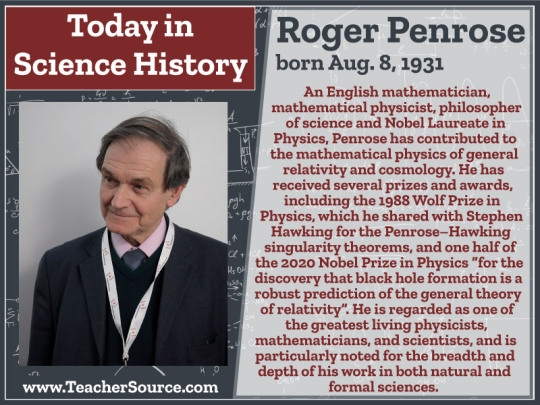
Roger Penrose was born on August 8, 1931. An English mathematician, mathematical physicist, philosopher of science and Nobel Laureate in Physics, Penrose has contributed to the mathematical physics of general relativity and cosmology. He has received several prizes and awards, including the 1988 Wolf Prize in Physics, which he shared with Stephen Hawking for the Penrose–Hawking singularity theorems, and one half of the 2020 Nobel Prize in Physics “for the discovery that black hole formation is a robust prediction of the general theory of relativity”. He is regarded as one of the greatest living physicists, mathematicians, and scientists, and is particularly noted for the breadth and depth of his work in both natural and formal sciences.
#roger penrose#mathematics#mathematicians#physics#general relativity#nobel prize#nobel prize winners#science#science history#science birthdays#on this day#on this day in science history
3 notes
·
View notes
Text
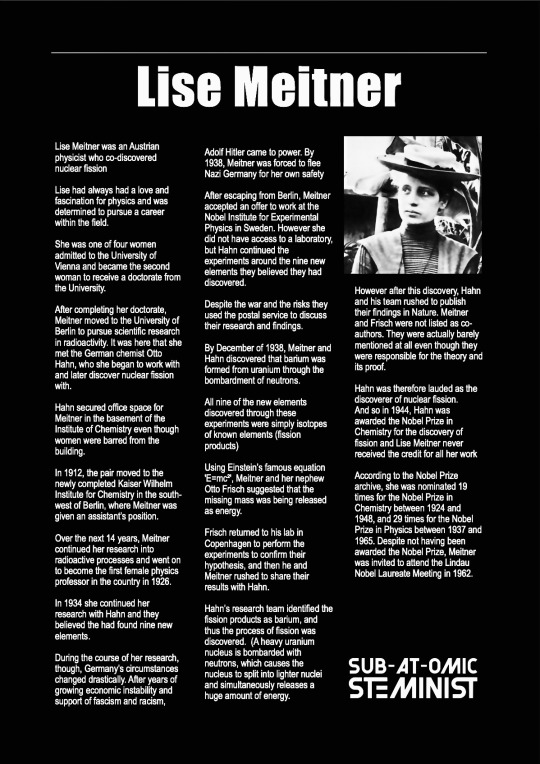
•Lise Meitner•
#steminist#physics#science#stem#mathematics#maths#women in stem#chemistry#nobel laureate#lise meitner#she deserved the Nobel prize#I will never not be mad about this#womens history
67 notes
·
View notes
Text
courage of stars, ch1 | writer’s commentary
Hello and welcome to the writer's commentary for courage of stars, chapter 1! I'm so excited to talk about this fic and share some background information with you, and I hope you will enjoy this journey as well!
Just a bit of housekeeping, the chapter-by-chapter commentary will go less into the symbolism/motif/narrative commentary (saving that for the end of the fic!). It's more here to get into some of the history and/or cultural tidbits, since both lend itself in both the form of Easter eggs to being pretty integral to the plot. I love getting to write Link Click fic because I get to tap into parts of me that I don't always get to do in other fandoms, so I am really excited to get into this!
As a note: I am neither a historian nor native-born Chinese. I have had the privilege of being raised in the culture and the anecdotes of modern Chinese history, but I feel it necessary to comment that this is not going to boast as 100% historically or culturally accurate, and so I encourage you that if something about the story piques your curiosity about real life events or culture or history, go ahead and read up on it! That being said, my depictions of history are based a lot of anecdotes or personal history, and I typically am not exaggerating.
Housekeeping done! Let's get into it!
***
“Sweet husband,” Cheng Xiaoshi said coyly. His tongue tentatively wrapped around the Cantonese pinyin, delicately trying the five extra tones for size.
In this universe, I've made both Cheng Xiaoshi and Lu Guang at least half Cantonese (because I write fic for ME). Cantonese is a different dialect than what they typically speak in the show, which is Mandarin. Only Ouyang Bubei is seen speaking Cantonese in Link Click. Cantonese is not mutually intelligible with Mandarin--that is, a native Mandarin speaker is not going to understand someone speaking Cantonese unless they already know and are familiar with the language. The fact that Cheng Xiaoshi and Lu Guang made no mention of having difficulty understanding Ouyang Bubei when he spoke exclusively in Cantonese made me jump onto the headcanon that they both grew up with the language.
Cantonese is considered an older language than Mandarin, or at least it is closer to what classic Chinese sounded like than Mandarin, which may have Mongol/Manchurian roots. It also is said to be more difficult to learn for a non-native speaker. Mandarin has 4 tones, while Cantonese has 9. So for Cheng Xiaoshi, who hasn't been speaking it for a while, he has to mess around with 5 extra tones while trying to impersonate this native speaker. Good luck to him!
***
"We may have another Chinese Nobel Prize winner for physics, right here in this apartment!” said another. “Your name will go down in history like Yang Chenning–you will make China move forward, maybe even surpass our neighbors. Who knows! Perhaps we can go to space too, like the Russians and Americans.”
During the CR, education more or less came to a standstill. Depending on when and where you were born within China, your high school education would have been very much delayed, and there were certain subjects where you would have severely been lacking. After the CR was put to an end, the country realised that they were very much lagging behind in STEM compared to their competitor countries, particularly in physics, chemistry, and mathematics. So there was a period right after the CR where those subjects were emphasized and highly encouraged--the shu li hua (数理化) priority that Lu Guang mentions later. It means Mathematics, Physics, and Chemistry, which China at that time considered the most important subjects for their academics to learn in order to propel China forward into progress and advancement, to catch up (and hopefully surpass) their neighboring countries.
Yang Chenning and Tsung-Dao Lee are two physicists of Chinese descent who had won Nobel Prizes for their contributions to physics in 1957. They eventually became lauded as role models for Chinese students of physics, when the sciences were more emphasized in studies. Yang had even come to China to help build science programs in the country after it had been more or less torn down during the CR.
***
Sun Yihan stood respectfully as Professor Lu passed him. Professor Lu gave him a small bow of the head, his eyes soft with sadness like a bruised fruit.
“Sun zi,” he said. “So the rumors are true. You really have returned to Peidi."
Sun Yihan smiled primly.
“I hope that isn’t too disappointing,” he said.
“Disappointing isn’t the word I would use,” said Professor Lu. “I am glad, but selfishly so.”
To study shu li hua was considered the best way to propel China forward, but there are some caveats to it. Studying physics alone, or studying mathematics alone, is a lot about calculations and theories. In order to use them for practicality, you need to apply things like engineering to it, which wasn't always offered (but one could pick it up along the way). Studying shu li hua was considered a way to more easily leave China and study elsewhere, for those who were ambitious and hoped for better opportunities.
Also, you will notice throughout the story that Sun Yihan (孙遗憾) will be called all sorts of names in this fic (Also, his 'Yihan' is differently written from the name of that one actor from the Link Click musical, or at least I assume so else I will feel bad for him lol). Professor Lu is calling him Sun zi, or 孙仔. The zi (仔) is like a little moniker that you call someone young, or like your kid/nephew/etc. Or even like your little pet. There's an affection to it, generally, and an indication that they are younger or smaller than you.
***
“He has much to be proud of,” Cheng Xiaoshi murmured. “He’s working with some of the first computers in the city.”
“And he used to dig clay to make bricks like the rest of us,” Sun Yihan said. “It seems that all those months spent in the countryside taught him quite little.”
So while one didn't have conventional school during the CR, there was still some kind of 'school' for the young people. That usually entailed sending them to the countryside to work one or several months with the farmers, the laborers, etc. For some people, that meant making clay bricks. You would live out in the countryside with these rural families to learn and appreciate their work, since the rural laborers were most uplifted during this time.
***
He heard shouts and chants thundering in his eardrums. A door being thrown open and heavy boots tracking monsoon mud across a floor, bookshelves thrown aside and papers strewn across a desk. Armbands tied around people’s sleeve, red with silk and blood. Streets full of bodies, some moving, some not. A hysterical scream, bubbling up his throat–
–a lonely photo studio, the neighbors’ judging whispers, children’s jeerings and pointed fingers, pain in the side of his head–
–two young girls clinging to her older sister, begging her not to risk the swim to the freedom of Hong Kong to escape oppression, before watching helplessly as she plunged into the sea–
–a little boy, sleeping soundly in his bed, and pain tearing through every inch of a woman’s body as she finally stood up to go–
I'll leave the first section alone, for now.
The third section is a reference to the freedom swimmers. When the Party took over China, those who wanted to escape to Hong Kong for freedom or to escape persecution would have had an extremely difficult time going to Hong Kong. For many of them, they would attempt to swim across the sea to reach Hong Kong, which was at the time a British colony and therefore not affected by the new regime. Many of those swimmers did not make it--drowned, or in some cases attacked by sharks--but there were some who miraculously swam and swam and made it to Hong Kong to a new life. I want to say this wave happened in the 60s or 70s.
Those are the notes for chapter 1! If you have any other questions or curiosities, feel free to ping me. Otherwise, thank you for reading and can't wait to see you for chapter 2!
11 notes
·
View notes
Text
Stiles: Lydia, get up, okay? You’re gonna dance with me. I don’t care that you made out with my best friend for some weird power thing, I don’t- Lydia, I’ve had a crush on you since the third grade. And I know that somewhere inside that cold, lifeless exterior, there’s an actual human soul. And I’m also pretty sure that I’m the only one who knows how smart you really are. Uh-huh, and that when you’re done pretending to be a nitwit you’ll eventually go off and write some insane mathematical theorem that wins you the Nobel Prize.
Lydia: A Fields Medal.
Stiles: What?
Lydia: Nobel doesn’t have a prize in mathematics. The Fields Medal’s the one I’ll be winning.
7 notes
·
View notes
Text
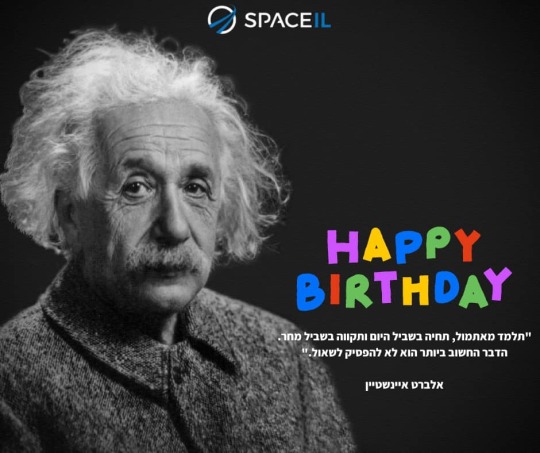
A genius is born...
Today we celebrate the birthday of the physicist who changed the world and made us understand the universe a little better.
Albert Einstein was born on March 14, 1879 (144 years ago) in a hall in Germany. At the age of 17, he attended mathematics and physics studies at the Zurich Institute of Technology but graduated with relatively low grades, mainly because of a driver to confront lecturers and prefer independent experiments.
Already in 1905 when he was only 26, Einstein published 4 articles that are considered to be cornerstones of modern physics. He completely changed the perceptions that were popular then about the relationship between space, time and matter.
And when it comes, it comes! In 1922, when he was only 43, Einstein was awarded a Nobel Prize for his contribution to theoretical physics.
And what about the space? The results of Einstein's research have a tremendous impact on modern space exploration and provide the basis for researchers of today.
So what do you think is Einstein's greatest contribution to humanity?
SpaceIL
#space#nasa#universe#happybirthdaytoyou#art#science#galaxy#moon#stars#spacex#cosmos#astrophotography#photography#celebrate
51 notes
·
View notes